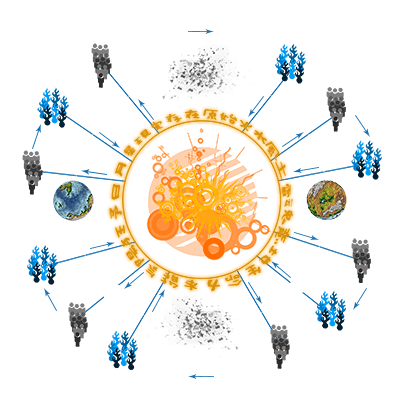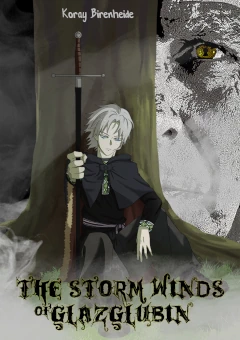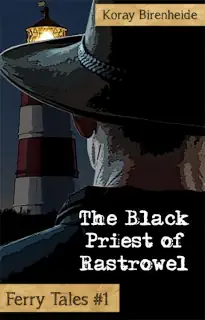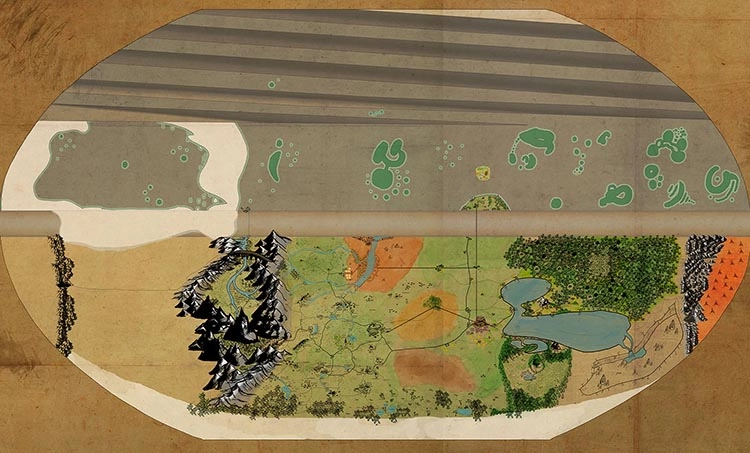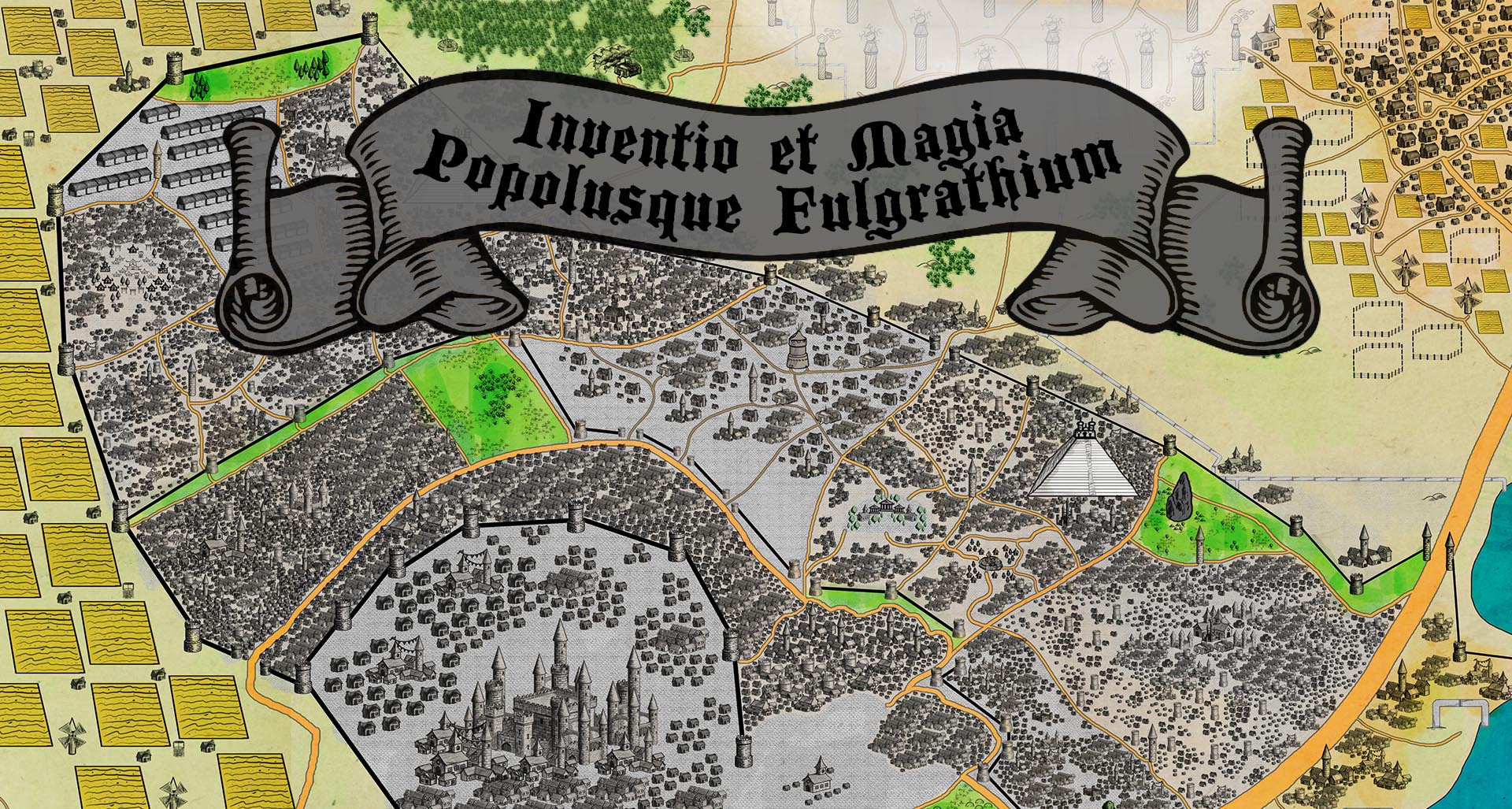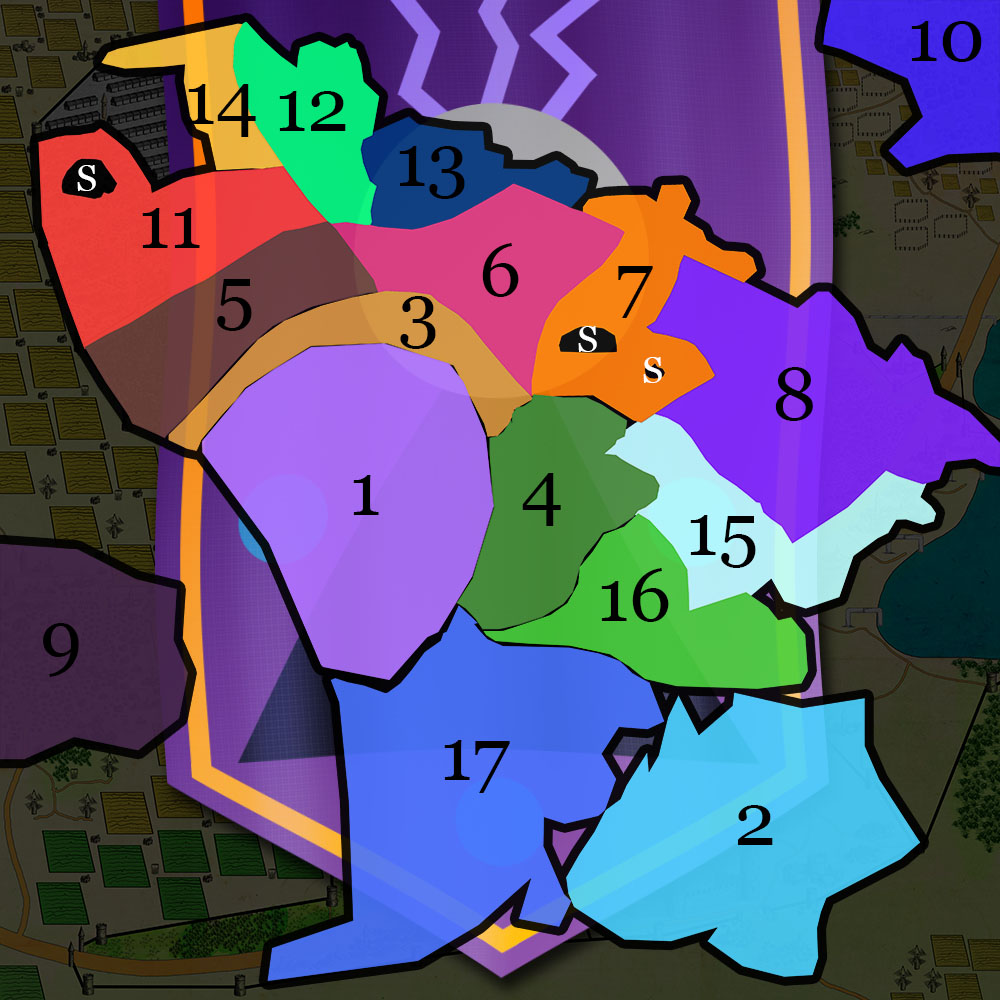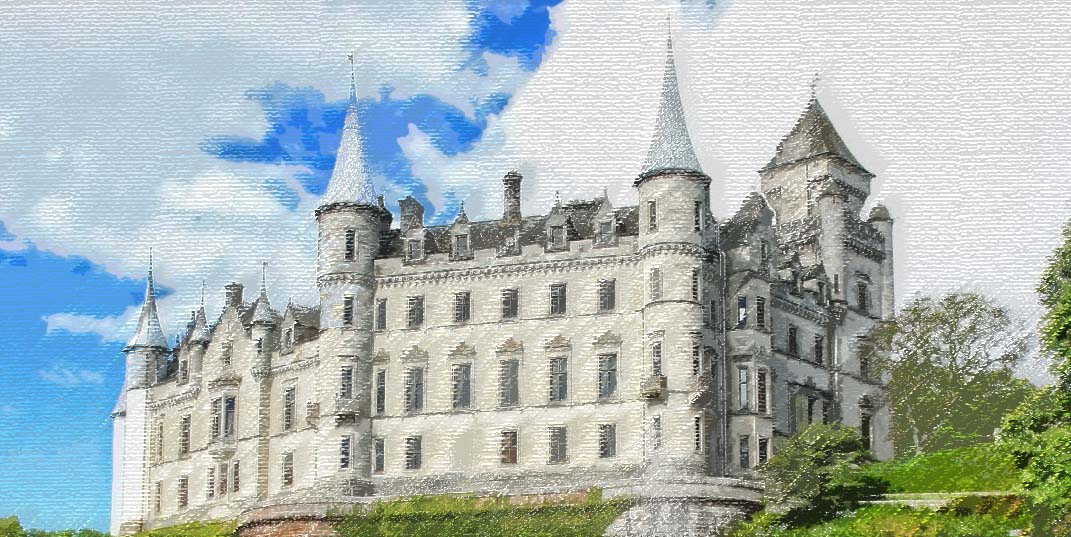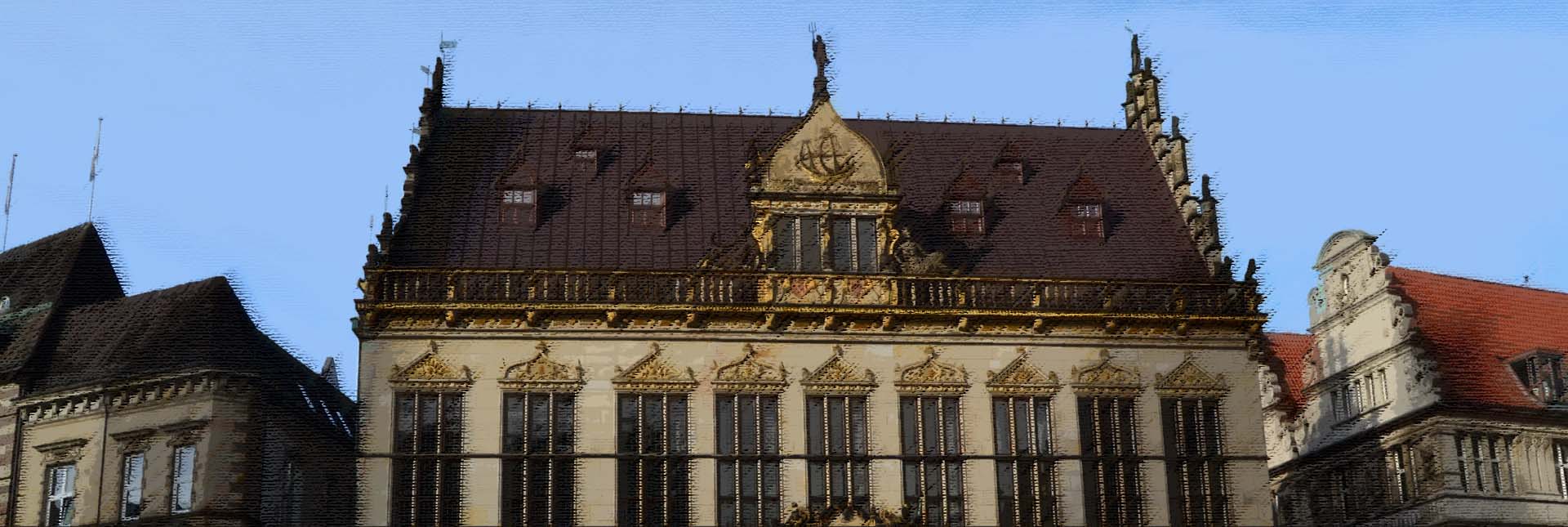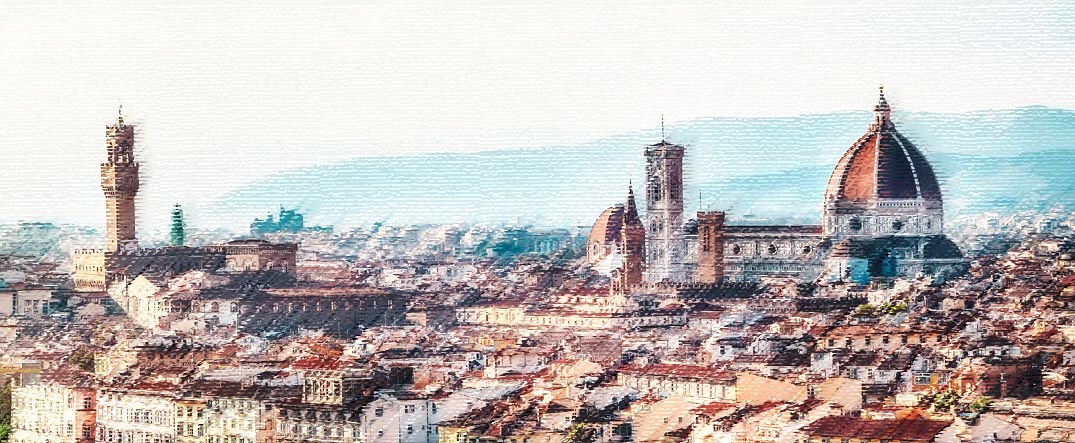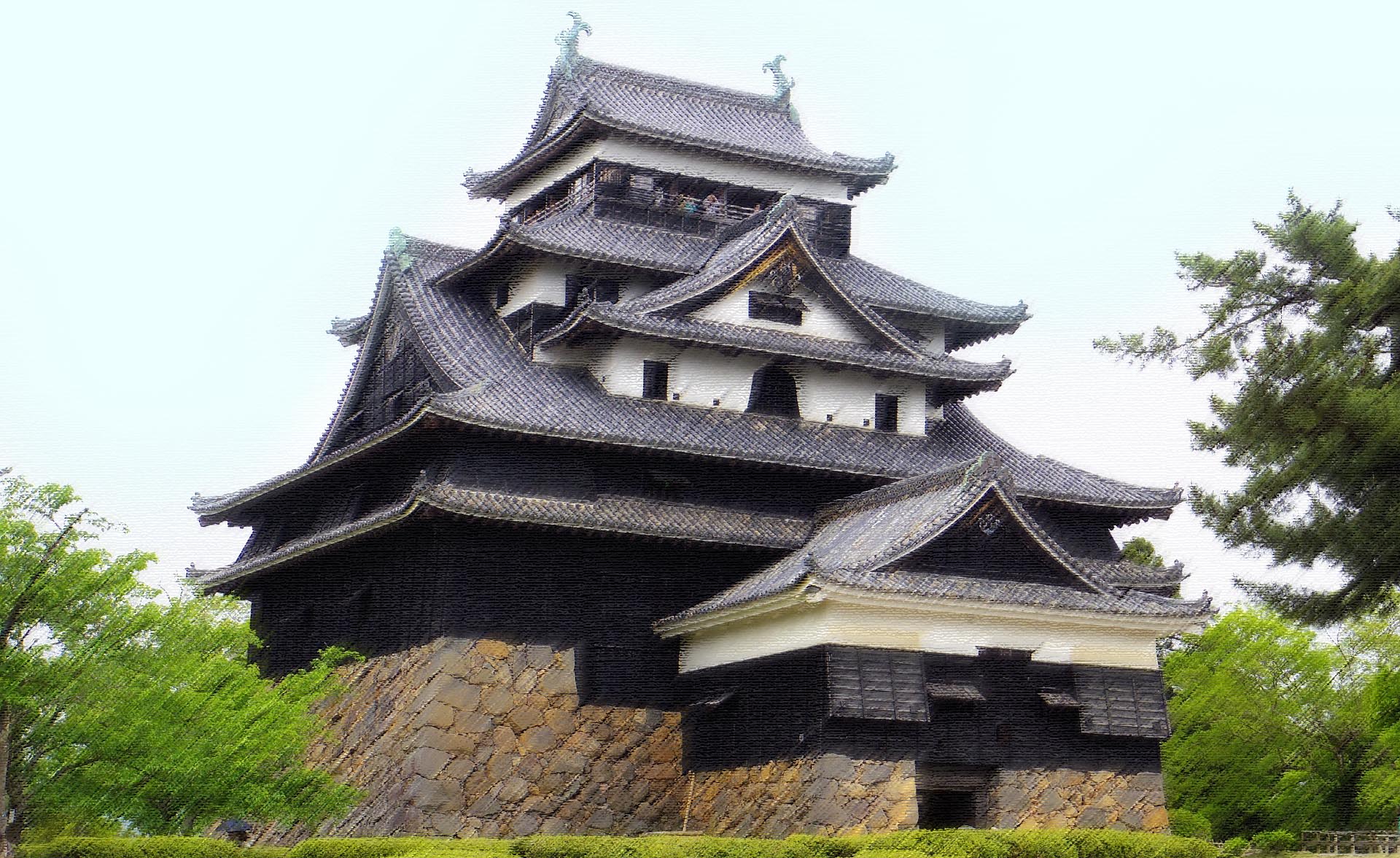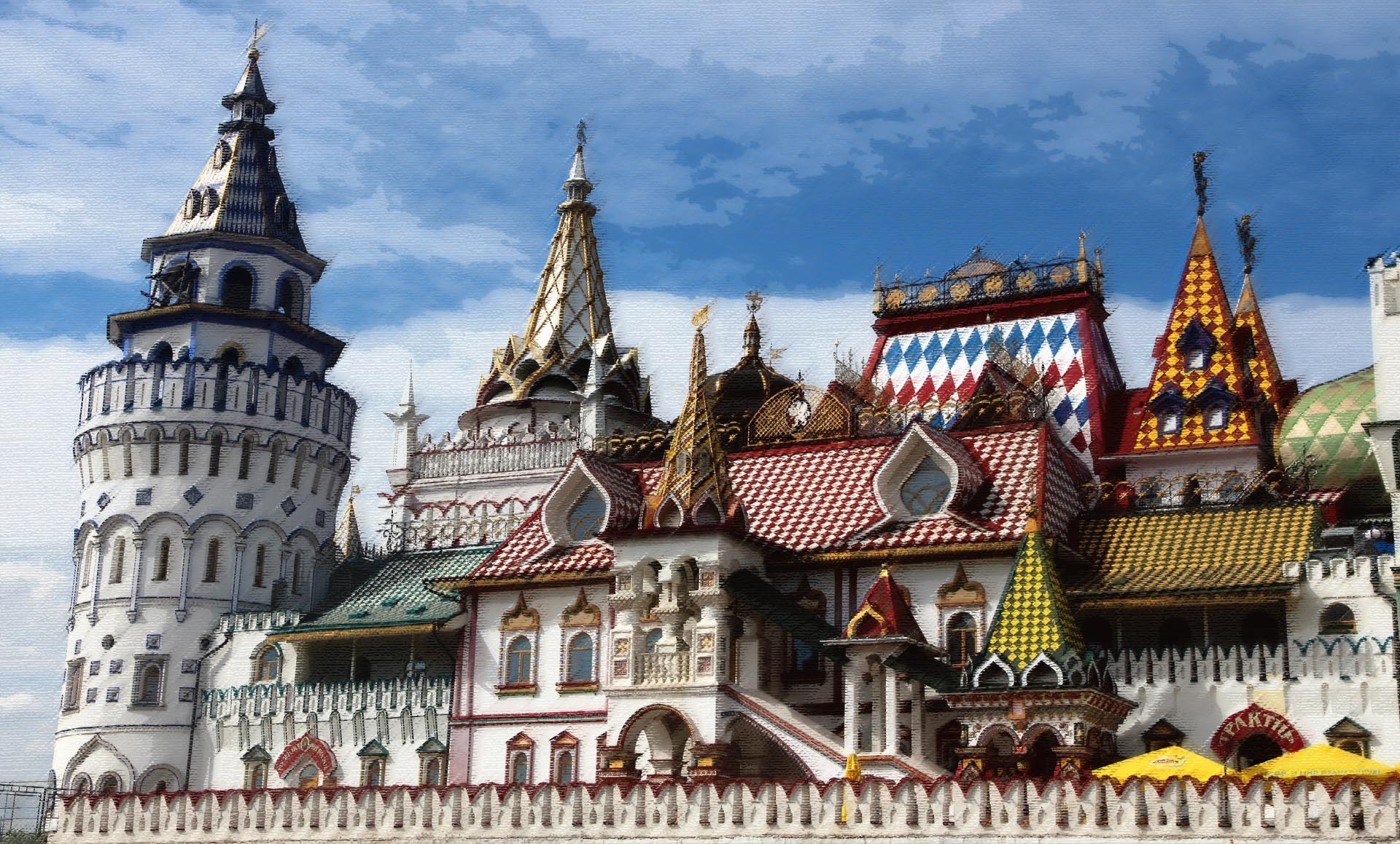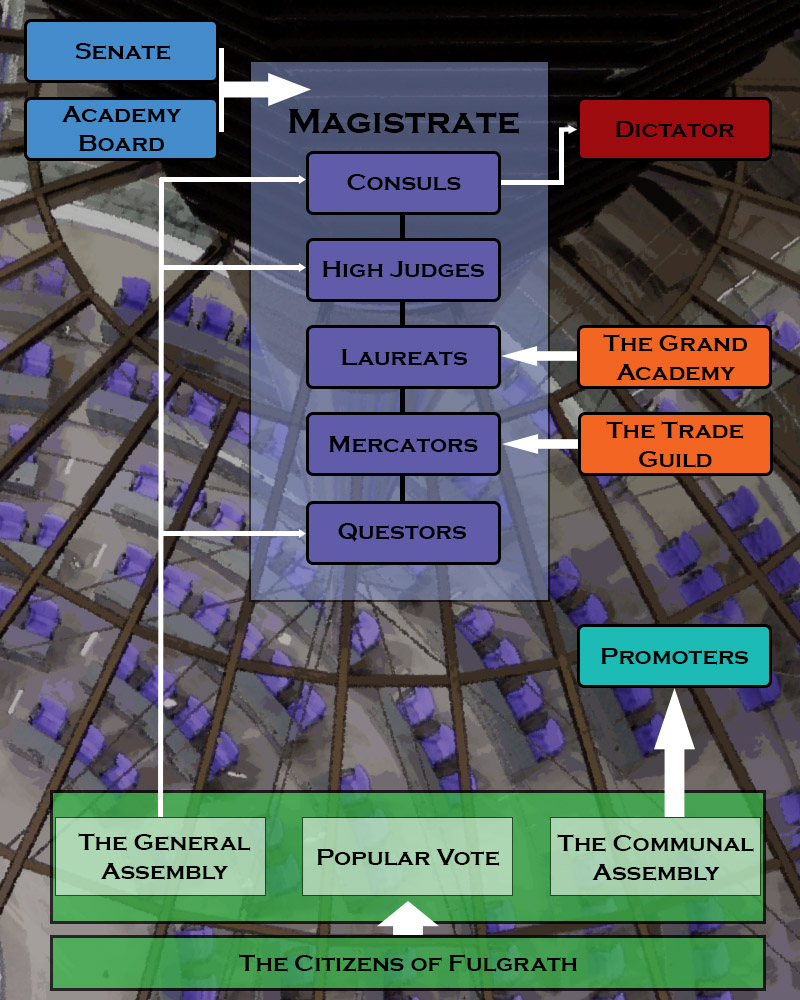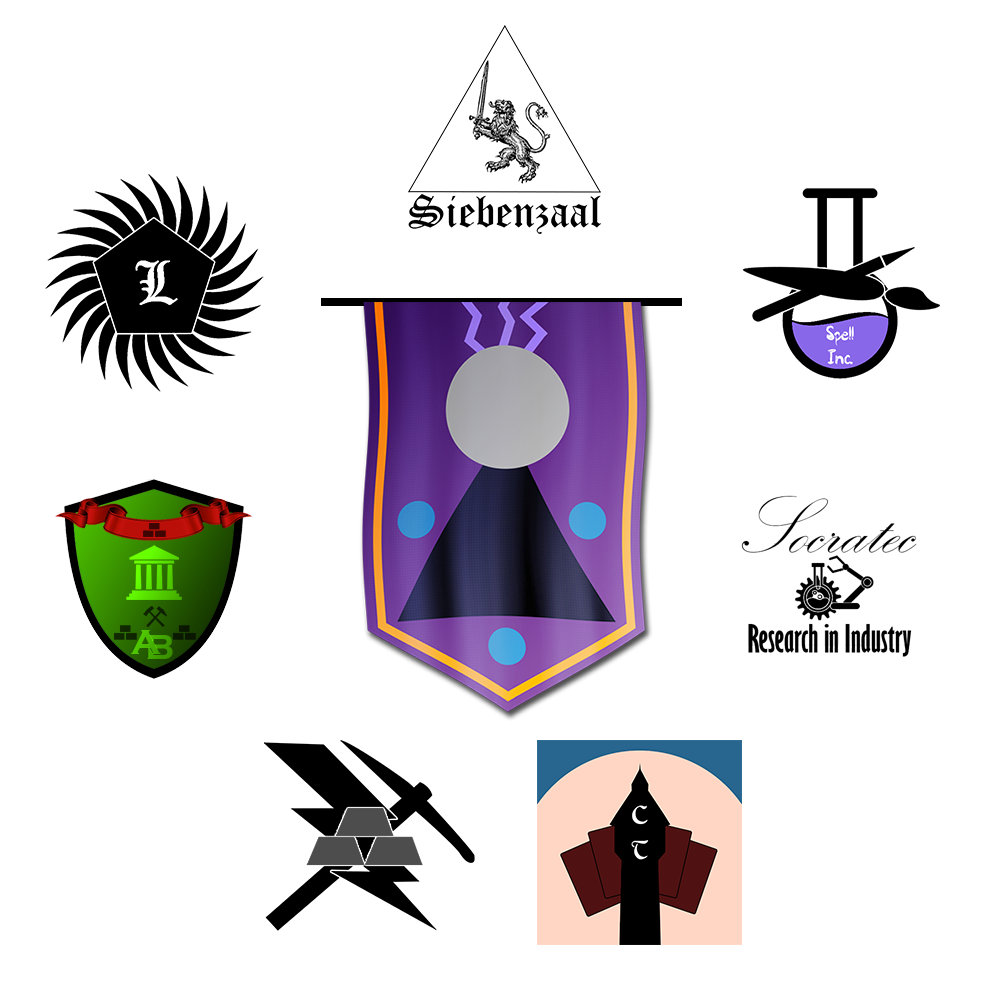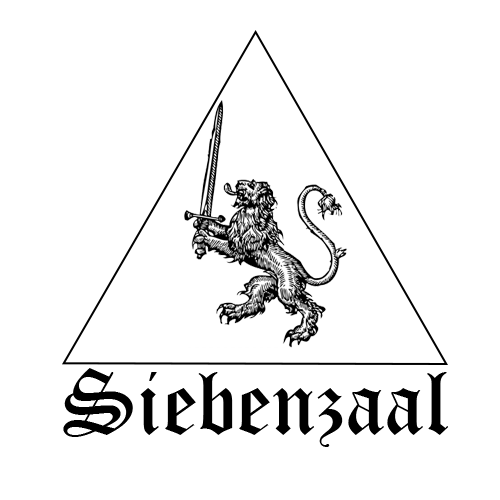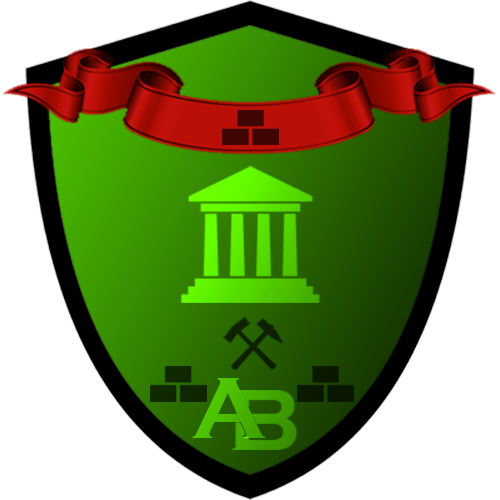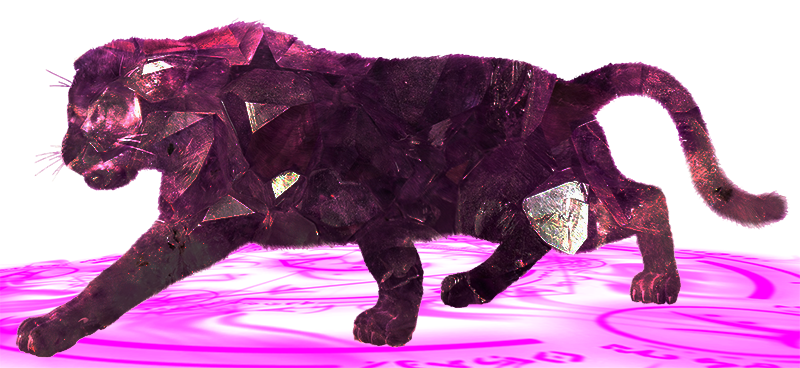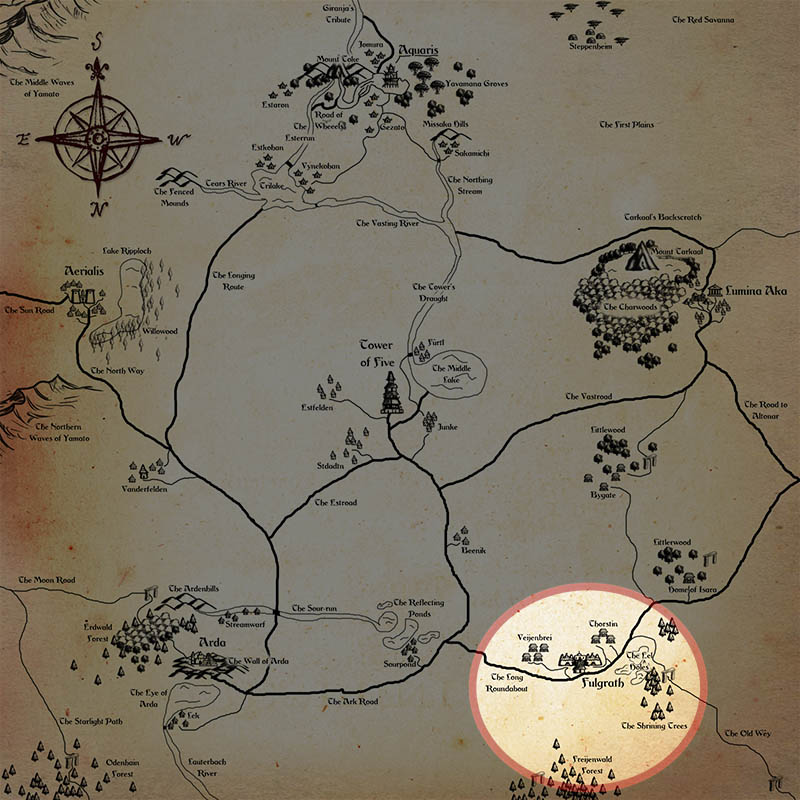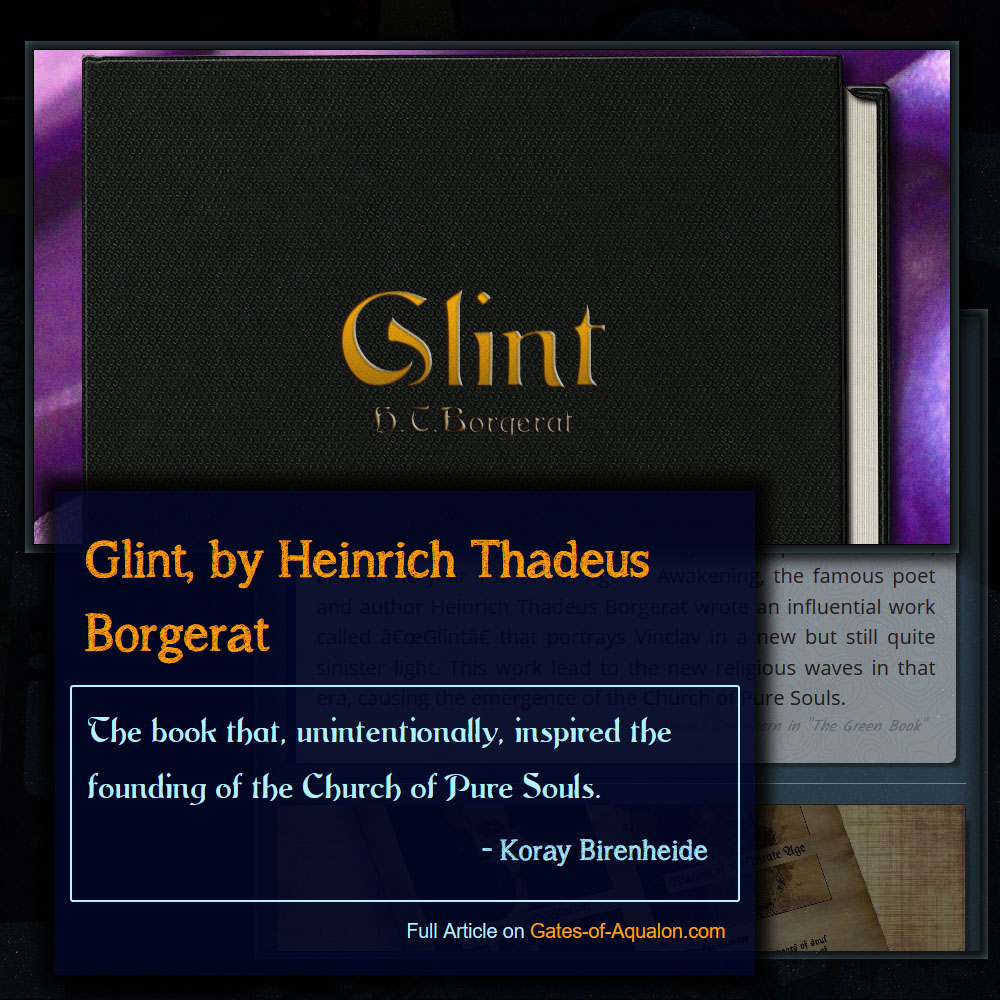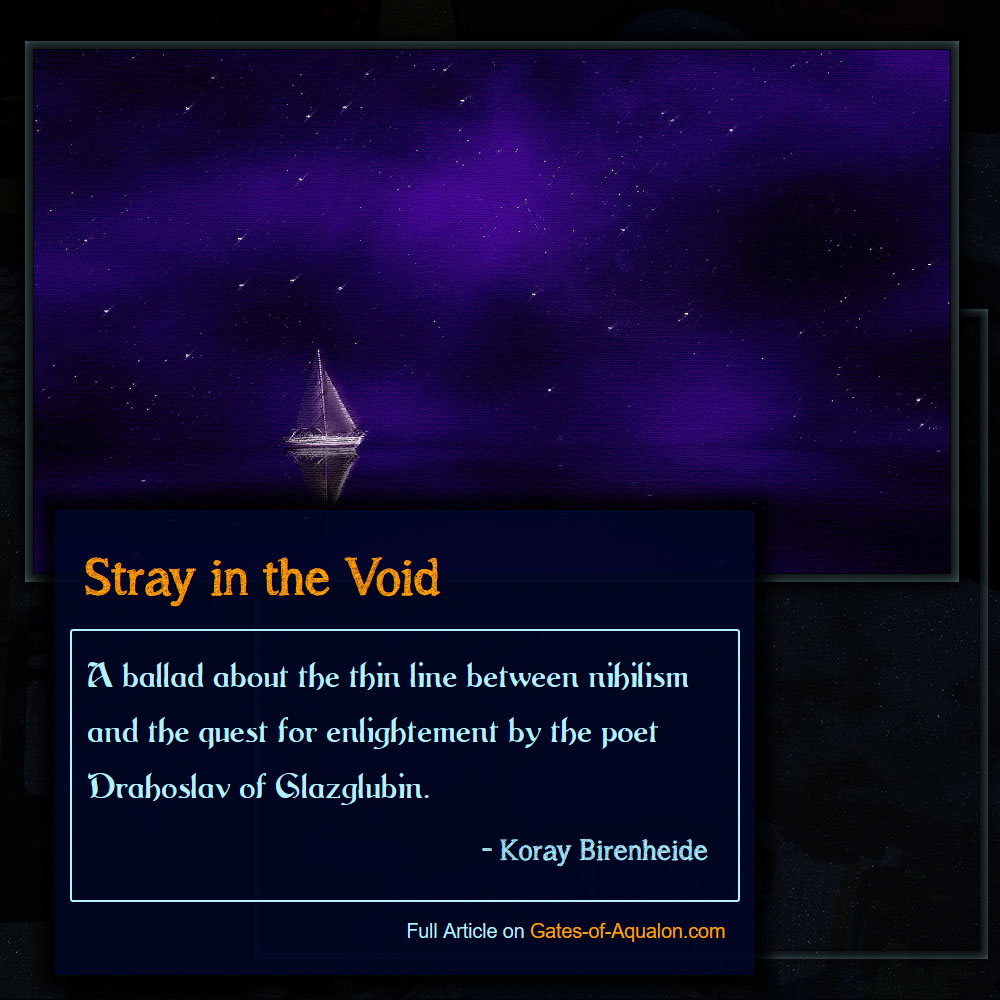The gargantuan effigy stomped along the cobblestone road with booming steps, rays of sunlight refracting through the intricate matrix of its amethyst-like body. It had the size and shape of a mighty rhinoceros from the Red Savanna up south, and Kendra marveled at the flitting specks of broken light, shattered into the multitude of colors only a prism could produce, as she sat on her behind where she had fallen. The boom, boom, boom of the bestial vehicle powered by superior spell ink mandalas had startled her so much that she had tumbled to the side of the road, and as she watched the creature and its rider pass by, carrying dozens of immense crates into the city, she beheld her first view of Fulgrath, the City of Lightning, for without realizing it, she had finally passed the mighty outer wall: Towers and tall buildings of stone and timber reached as far as her eyes could see. It was as if an ocean of houses had been raised out of the landscape. More effigies wandered in the distance, carrying heavy loads, pulling large trailers; a sudden brrrrrrring snapped her attention back to the west, where a man on a bicycle rang his bell to get her to move. She scrambled backwards and watched him drive by, followed by three more. Though just at the outskirts, the city was already this busy with no end of the traffic in sight, something that utterly overwhelmed Kendra. She stood up and brushed the dust from her pants. "Going into the city?" a kindly man asked. He seemed to run some sort of kiosk by the roadside. "Ah, yes," she replied a bit flustered. "First time here, eh?" "Yes." "Anywhere particular you're going?" "Um..." she produced a crumpled piece of paper from one of her pockets. "Karlister, I think? My aunt lives there." "Hoho, she ought to be well-off then. You'll want to take a travel gate though, it's a long way to Karlister. There's a couple of bicycles next to the shop. Pick one, they are not difficult to use. If you don't feel confident, one of them has little support wheels. Drive down the Long Roundabout here until you get to that tall tower over there, the one lakeside; in there you can use the gate to get directly to Karlister. If you ask one of the city watchmen, he'll tell you how to get to your aunt's street; they wear the purple uniforms." "A bicycle? Aren't you uh... afraid I might steal it?" Kendra wondered, surprised by his openness, a trait she did not usually expect from city folk. "Are you going to steal my bicycle?" he asked with a raised brow. "What? No, of course not!" she exclaimed in surprise. "Works for me. I'd appreciate it if you left a little tip in the jar here, and feel free to buy a newspaper or something, this one's got the scoop on all the theater plays today and tomorrow - if you're into that sort-of thing. Just put the bicycle into one of the bicycle racks by the tower when you're there, it'll get back to me." Kendra perused her purse for a couple of coins and put them into the jar. The man nodded with a kind smile. "I think I will take the theater one!" she said with a happy grin. "There you go," he replied, "thank you for your business." "Thank you for your help!" she replied, beaming, and went to the side of the kiosk to check out a bicycle. <Hm, support wheels or no support wheels?> She made her choice and off she went, off to Fulgrath.Fulgrath: the City of Lightning, the Aluminum Cradle, the Technamagic Bridge. This is a city with many names and many faces. Within its seventeen districts, one may find booming businesses, skilled artisans, cunning merchants, lofty scholars, and a smorgasbord of many cultures. Indeed, the city has often been referred to as the Melting Pot of the Middle Lands, for its unbridled growth and wonder has attracted many immigrants from all over Aqualon throughout the Great Peace, the Age of Gears and Elements (GE).
Fulgrath, from Outpost to Metropolis
The Founding
Planned, financed, and constructed during the Founding of the Five Cities between 251 and 312 GE, when the Five Keepers of the Elements came together to reform the Middle Lands Magocracy, rooting its power and prosperity in five great cities to each of its corners, Fulgrath grew out of the humble hamlet around Bernschloss castle, the seat of power for the margrave of the north-west during all of the Age of Awakening (AA) and the Age of Heroes (AH), the two ages that preceded the current Age of Gears and Elements. With the founding of Fulgrath as one of the Five Cities, the power of the margrave and his family, the Asterocks, waned in the shadow of the new Great Charter of Fulgrath, which outlined the newly formed government, a strong and well-regulated republic, which put much power into the hands of the people while maintaining the significant influence of the Keeper of Lightning, the original ruler of the region. Still, in securing senate seats and maintaining their ancestral home situated in the heart of Fulgrath, Bernschloss Castle, the Asterocks are far from powerless within the Republic of Fulgrath. Just like the financial aid the Siebenzaal provided during the founding of Fulgrath to make the monumental building projects possible that turned the city into what it is today, the support of the Asterocks secured their place of power among the upper ranks of the city and continues to do so to this day.The Grand Academy
Just as important as Bernschloss castle is the Grand Academy, which had stood long before the Founding of the Five Cities, accumulating ever-growing storehouses of knowledge and discovering arcane forms of lightning magic and beyond. Their support during the founding was invaluable, and what is now known as the Grand Academy of Fulgrath is its own district in the charter, with vital organs of political power at its behest. Though not a technocracy like Altonar or Miyako Fluxum, the direct inclusion of learned scholars and philosophers in the operations of the government has done much to ensure the prosperity of the city over the course of its existence. Additionally, the significant prestige of the academy continually draws in scholars from all over the world seeking to broaden their horizons, who in turn provide a steady influx of highly qualified individuals with new ideas and perspectives.Power in Growth
Ever expanding, more and more old businesses of the city began to incorporate themselves, and the economy of Fulgrath, to this day, is one of the most effective in the entire world, so much so that even advanced technocracies such as Altonar and Miyako Fluxum turn to Fulgrath for manufacturing as well as purchasing large quantities of precious aluminum and aluminum alloys.Metropolis
In its ever growing prosperity, the city soon overtook the other four capitals of the Middle Lands, boasting the largest population among them, which is in large parts owed to the significant immigration attractiveness of Fulgrath. People from all regions of the Great Land and beyond have traveled to seek labor and education within the walls of the city, and the city has aimed to provide. Additionally, the inclusion of foreign embassies has allowed for the organic growth of secondary cultural centers in Fulgrath, expanding its cultural heritage and spectrum further with diplomats from the Yamato Kingdom, Altonar, and even the secluded western nation of Vechnaya Bramma bringing their families to live in Fulgrath, creating cultural districts with their own specialty products, styles of architecture, and ideas.The Seventeen Districts of Fulgrath
District 1, Bernschloss
Bernschloss was the name of the large fort of the Margrave of the North-West during the Age of Heroes and before the Founding of the Five Cities. The hamlet surrounding it was known as Fulgrath and would later become the heart of the greater city during the expansion efforts. Once the city was large enough to be divided into its first five districts, the name of the fort was used to describe this one. Bernschloss became a district with the ratification of the charter in 292 GE. Completely cobblestone-lined, with the exception of small gardens and parks, Bernschloss is a densely populated and historic district, and many houses still have the classic half-timbered look, being preserved thanks to their monument protection status. The castle Bernschloss in the center of the district used to tower high above everything else until the construction of the Pyramids of Fulgrath, though they are not much taller in actuality. Only the Grand Academy of Fulgrath, which lies to the northern side of the city, for away from the center, has higher spires, some of which were built for use in astronomy.District 2, the Grand Academy of Fulgrath
The Grand Academy of Fulgrath was a district of the city since the ratification of the charter, just like Bernschloss. However, during the Founding, it was mostly comprised of the academy buildings themselves, which included the fortified castle, a large library, and some rather lackluster housing for the least wealthy students, who couldn't afford rent inside the castle. In the centuries since the Founding, however, the Grand Academy of Fulgrath has made good use of the lands afforded to its proper district, investing into infrastructure and housing, increasing district revenue and allowing for ever increasing enrollment numbers, while also pulling in non-academics such as traders and artisans, which in turn improved living conditions for the students.District 3, Markhorn
The Markhorn district was also established in 292 GE. Already, dense population centers had grown outside the now inner walls of Fulgrath, represented by the Markhorn district and the Karlister district. The Markhorn district initially housed moneylenders and wealthier merchants but has slowly developed into a pleasure district over the centuries that followed the Founding. These days one may find all sorts of entertainment in the streets of Markhorn.District 4, Mittelmarkt
The Mittelmarkt is the largest of the open market places in Fulgrath. While the population of the district is low compared to its size and only a handful of large buildings exist in its center, a large portion around it completely cobblestoned, the economic and financial power of the district is extraordinary. It was also established with the other four initial districts. The area around the wide market place is densely populated by merchant families and the Trade Guild, which has a huge stake in this district. Every morning, long before the sun rises, an almost Völkerwanderung-like migration will occur here when traders from all over the city arrive with their carts or backpack processions, setting up stands everywhere. The entire bazaar is strictly regulated and thoroughly taxed: Stands won't appear just anywhere due to the risk of being severely fined. Rather, blueprints for the layout of each day's bazaar are drawn up and enforced by the Trade Guild.District 5, Karlister
The Karlister district, the last of the original districts, initially housed many of the artisans of Fulgrath. This is still the case, though a large number now also live in Gul'heine, Finstral, and Klapperstadt, due to their strategic locations around the Forge. In the centuries since the Founding, many merchants have moved into historic Karlister, and with them came taverns, inns, and public bathing houses, all the daily comforts of respectable living. These days, real-estate in Karlister has become far more expensive, and many heirs of ancient artisan families are looking to sell or to turn their properties into more lucrative ventures, such as inns.District 6, Forge
The Forge district was the first of the new districts, which have to be drawn up and ratified by the magistrate. It contains a limited amount of living space, but is cobbled over as a measure against fires, and all buildings are likewise made of stone. The available space, rather than containing houses, often contains nothing, leaving ample room for transportation of goods, which is an important part of the day-to-day activities of the district. Large buildings containing industrial smithies, furnaces, and other kinds of manufacturing plants are the true inhabitants of the Forge, and here many of the artisans of the city work every day, coming from all over by way of the Travel Gates of Fulgrath.In the Forge in Fulgrath, the central building is shaped like an old-fashioned kiln and generally referred to as just "the Furnace". Within its walls, the largest transmutation furnace of the world is located, and it churns out complex materials twenty-four hours a day, eight days a week, supplying the entire Forge district and the Grand Academy of Fulgrath.Fact 158 taken from Old Tim's One Hundred Facts about Aqualon, Volume 2
District 7, Klapperstadt
Klapperstadt, located next to the Forge district, is home to a number of artisan families, though most who live here are on the wealthier end of society, owning businesses of their own. Due to two special zones, the Altonar embassy and the Brammenfort embassy, which represents the lands of Vechnaya Bramma, being located in Klapperstadt, the district is also home to a number of diplomat families and thus rather well off. In the past two centuries, the district has expanded beyond the outer city walls, housing less wealthy citizens. While this skews the political interests of the district in the view of some older inhabitants, the influx of commerce created by the extensions has kept them from speaking out too loudly.District 8, Steinau
The district of Steinau is named after the Big Rock Monument, which is located in Big Rock Park. Its most influential building is the northern Pyramid of Fulgrath, which was constructed by the business tycoon Herbert Siebenzaal and his descendants. The building is a huge office complex that employs a staggering amount of people. The less densely packed northern region of Steinau has its own economy, which developed around the traders and artisans who set up along the Long Roundabout and was supported by increasingly impressive infrastructure.District 9, Veijenbrei
Veijenbrei, a town located to the east of Fulgrath, is often called the corn chamber of Fulgrath. Initially just a small village in fief to the margrave, with the Founding of the Five cities and the explosive growth of Fulgrath, Veijenbrei petitioned for and was granted district status in 426 GE.District 10, Thorstin
Thorstin is a smaller district than Veijenbrei, but is quite significant due to its location north-west of the city, right next to the Molotov towers and cloud stacks of the lightning farm. Many engineers live in Thorstin for ease of access, however, the town of Thorstin is also a center for agriculture, providing grains and meat to the city.District 11, Vallahal
Vallahal is a newer district, which was only acknowledged in 722 GE after the outskirts of Karlister had been growing more and more and the city wall had to expanded. It's name comes from its initially high population of Nordmen, which was slowly supplanted by citizens of Yamato descent after the establishment of a permanent Yamato embassy, another special zone, in 1280 GE. Nowadays, the descendants of the Nordmen who originally lived throughout Vallahal have moved to the fringes bordering Finstral and Leuven.District 12, Finstral
Finstral is not very densely populated but houses some of the most influential businessmen of Fulgrath, sporting lavish mansions and greenery all about. The district's heart lies in the southern Pyramid of Fulgrath, which was also constructed by the Sevenzaal family centuries ago in the thirteen-hundreds GE. Though used as a large-scale office building just like the northern Pyramid of Fulgrath, the employees of this one generally have a much higher average salary as this is also where the Fulgrath Exchange is located. This location also puts it relatively close to the Molotov towers and cloud stacks of the lightning farm, which, due to the severe electric hazard of the region, cannot be safely fitted with a travel gate.District 13, Gul'heine
Gul'heine has become a home to artisans in the past centuries as it predominantly borders the Forge district. Many smaller artisan shops are in the district itself, which is located strategically at the southern gate of Fulgrath, allowing for people trickling in from the south-west to come through the Gul'heine district.District 14, Leuven
The small district of Leuven is heavily controlled by the Church of Pure Souls, which took roots in southern Fulgrath during the Onslaught of Balsibart in the sixteen-hundreds GE. Fleeing masses from the Corsic Ocean migrated across the Great Land, some of them settling in the ever growing metropolis of Fulgrath and carving out a life for themselves. The power of the Church in this district is rather extensive, and Promoters elected here are usually high-ranking clergymen. They also maintain the southernmost Graansinger Park, where they host regular festivals to promote the district and the Church. Most workers of the district are employed in logistics as the large warehouse-packed part of the city is right next-door to the east-side of the district.District 15, Whitehall
Whitehall, a relatively new district, separated itself from Steinau in 1333 GE, when the section of the district became more and more wealthy and densely populated due to its close location to both the Mittelmarkt district and the Long Roundabout, ensuring its growing prosperity. Aside from the region around the Yamato embassy in the Vallahal district, Whitehall is the only other district with a large Yamato shrine dedicated to the spirituality of ur-soulism. This is also the largest lightning shrine on all of Aqualon, an element rarely enshrined elsewhere.District 16, Saxamagia
Saxamagia was initially inhabited mostly by students of the Grand Academy of Fulgrath who could not afford to live on the prestigious campus. However, due to its location at the Long Roundabout and the beautiful Fulgrath Central Park between it and the Mittelmarkt district, it has become a rather popular district to live in, becoming ever more densely populated and gentrified and thus ever more pricey, in fact pricing students right out of the area.District 17, Dunwald
Dunwald, the newest district, was initially where the lower barracks of the Fulgrath military were located. As the Great Peace began to settle in the centuries surrounding the Founding of the Five Cities, more and more families moved into the area, and while the infrastructure is not on the same level as the inner city, the town-like feeling of the district has also led to growing gentrification. This and the still widely available building space within the district have garnered interest from investors all over Fulgrath, and Dunwald has seen growth spurts and influxes of wealth come and go intermittently throughout the past five centuries. Once the district has grown densely populated and wealthy enough, it is the most likely candidate for another district split, producing the eighteenth district of Fulgrath.Important Locations in Fulgrath
The Grand Academy of Fulgrath
The Grand Academy of Fulgrath is unusual among the Academies of the Middle Lands in that it teaches lightning magic only as one of many faculties and is renowned for the Faculty of Weather Science it houses, which is second only to the Shunkashûtô Institute of the Yamato Kingdom. Maintaining an unusual trade arrangement with the technocrats of Miyako Fluxum, they have procured, tested, and implemented several powerful machines that were created to be operated by lightning magic. There is a certain degree of internal difference in opinion within the other Magus Academies of the Middle Lands regarding the Grand Academy of Fulgrath's dealings with technocrats as there is still quite a bit of enmity between these and the mages. The diligent pursuit of knowledge, however, is perceived as laudible by many, hence the dissension.
- From "A Brief Primer on the Magus Academies of Aqualon
The Grand Academy was called just that in the period between its founding in 93 AA and the Founding of the Five Cities between 251 and 312 GE and was renamed to "the Grand Academy of Fulgrath" with the completion of the initial great expansion project. Since before the Age of Heroes, the GAF was known as one of the great institutes of learning in not just the Middle Lands but the whole world, and though technocrat-run institutes such as the Van Maxwell School of Logic and Sciences and the Altonar University have often had a leg up on them in the in the academic world of the natural sciences, the arcane studies of magic have kept the GAF always up there with the most prestigious names in academia.The Academy Library
The Academy Library of the Grand Academy of Fulgrath is one of the great libraries of the world, and the main building in addition with various specialty libraries located in the vicinity holds many million tomes, papers, and booklets. Scribes regularly make copies of ancient manuscripts to use as gifts for the Black Sanctum Archives of the Brotherhood of the Null, located to both the Eastern and Western Walls of Weltenend. Intrepid scholars and field researchers take these "gifts" all the way to the ends of the world and deliver them to the Null. There they are in turn allowed to make copies of rare tomes inside the archives of the Null and bring them back to Fulgrath.Bernschloss Castle
The old Bernschloss Castle was under the control of the margrave of the north-west and his family before the Founding of the Five Cities. When the Fulgrath Charter was drawn up, the Asterock family, which owns the castle, signed to loan certain parts of it to the city so as to provide chambers for the magistrate, senate, and political assemblies as well as the Magister Court. In return, for this and control of the revenue from the lands of the Asterock family, the family's status and ownership of the castle was guaranteed by the charter, including a number of senate seats.The Eel Holes
The Eel Holes are three mid-sized lakes with surprising depth, connecting Fulgrath to a vast underground supply of saltwater, thought to be what some call "the Secret Ocean". After desalination, they supply the daily needs of the city, irrigate the farmlands and power the cloud stacks. Giant pipes pump the water out of the ground and transport it to the various places it is needed. Additionally, buildings sometimes referred to as battery towers stand at their shores, holding powerful cables with attached counterweights that are sunk into the water. These are used to store initially electrical energy in mechanical form.The Bauxite Mines
There are two major strip mining operations for bauxite in Fulgrath, a rock consisting mainly of aluminum-rich minerals. The closest and newer one is the bauxite mine at the south-western tip of the city, in the small Junkerwald woods. Here, a large-scale mining operation of the Aluminum Guild pulls many tons of the precious ore out of the ground every year, sending it to the aluminum smelters for processing.The Lightning Farm
The lightning farm of Fulgrath supplies the city and the aluminum smelters with much-needed electricity. For this purpose, the ingenious "Molotov Tower", designed by Rudolph Molotov, was utilized: a sort of super-capacitor built to attract and store the electricity of lightning strikes. The initial inspiration for constructing such a machine allegedly came to Molotov when he was traveling the world with his colleague, friend, and contemporary genius Vincent Kunibert Greenhorn during their visit to the island of Preliumtarn, a place rumored to contain a message from the Great Clockwork etched into a secret cave. The island is infamous for having violent lightning storms almost every day of the year, inspiring Molotov to draw up his designs with dreams of harnessing such immeasurable energy.
When the city of Fulgrath was planned and constructed around the academy between 251 GE and 312 GE, more Molotov Towers and so called Cloud Stacks were constructed, which were meant to vaporize large quantities of water harvested from the Eel Holes, small but incredibly deep bodies of water nearby which connect to a vast underground supply. Generated clouds were agitated with lightning magic to create targeted lightning strikes into the Molotov Towers. The magical industrial revolution started two to three centuries earlier in Fulgrath compared to the other four cities of the Middle Lands, who started out with the invention of Spell Ink in the 9th century GE. In 350 GE already, the streets and houses of Fulgrath were powered by electric light, long before the invention of magus lamps that use fire magic spell ink mandalas.- Fact 109 taken from Old Tim's One Hundred Facts about Aqualon, Volume 2
The Angel Stones of Fulgrath
The Angel Stones are powerful magical resonators created by Angel Saxon stone cutters. They are placed in circles with a gate in their center, and they connect this world with the realm of Asgard, far away. Nordmen who wear a lodestone around their neck during their time of death are not drawn towards the Great Clockwork but the nearest Angel Stones instead so that their soul can travel to Asgard and be guided to Helgard by Freyja, the goddess of the dead.
The Angel Stones were to be spread far and wide across the Great Land by decree of Lady Freyja, and the Angel Saxons were given leave to take any measure necessary to do so. The only way to erect their stones in the Middle Lands and have them maintained, however, was to strike a bargain with the Middlish men. This is how powerful magics finally found their way into the Middle Lands in the 4th century AID.-Fact 12 taken from Old Tim's One Hundred Facts about Aqualon, Revised Edition
While these then furthest Angel Stones were located in the vicinity of Mt. Tarkaal where Lumina Aka lies today, such stones were also erected around the north-west of the Middle Lands, and the ones near Fulgrath have been declared a cultural heritage site during the Founding of the Five Cities, which became one of the selling points for Nordic immigrants moving to Fulgrath.Big Rock Monument
The Big Rock Monument in Big Rock Park in the district of Steinau is one of the most visited cultural heritage sites of Fulgrath. It is, indeed, a big rock, having the approximate height of twenty meters. During the Great War, also known as the Age of Heroes, the Keeper of Earth, Sorin Markhorn, crushed the Old God Belobog, son of Odin and Frigg, beneath this gargantuan rock, winning the Battle of Nordmark in 19 AH. Belobog's remains are beneath that rock to this day.The Grand Market Hall
The Grand Market Hall of the Mittelmarkt is located in the center of the huge, cobblestoned market place where hundreds of stands are set up every day to form a great bazaar. It is surrounded by ten large warehouses and offers a variety of services: The most choice wares are displayed here every day, including the Fulgrath fish market, sporting Aquaris and Aerialis fish transported using Aquaris cool-box magic engines, fruits from all over the Middle Lands, and expensive luxury goods from all over Aqualon. There, also, one may find a number of prestigious restaurants and antique shops, snugly fit into the hall, turning the whole place into an experience for many visitors each day.The Pyramids of Fulgrath
The Pyramids of Fulgrath were built by the Siebenzaal family, the wealthiest family of the city, back in the thirteen-hundreds GE. Inspired by the mighty pyramids of the long fallen Arkhamanthali empire and to a lesser extend the still pretty impressive pyramids of the current Kingdom of Arkatrash, these great monuments were constructed using white marble from Lumina Aka. They were not built as tombs or to elevate the castles on top, though they certainly did the latter, but to actually act as well-utilized business buildings. One was made to be a grand hotel, while the other became an office building, both with lavish interiors and clever architecture to have high windows concentrate daylight into the interior in a way that made it seem much more open than it was, given the lack of windows anywhere else. Lighting and smart color schemes made up for the rest and the buildings won many architectural awards in their time, finally being put under monument protection in the 1420s GE. Today, both pyramids are office buildings for Siebenzaal Incorporated, though the castles on top are high profile casinos and hotels.The Guildhall of the Aluminum Guild
With the rising wealth of the Aluminum Guild throughout the second half of the current age, they have managed to purchase wide tracts in the growing areas of Steinau that border the Long Roundabout. Here they hold regular meetings between the head artisans and managers of various smelters and smithies as well as the mining guilds that are part of the greater Aluminum Guild. The guildhall, both large and lavish, was partially constructed out of a small, old castle and extended with several large wings, holding trade halls, conference chambers, guild vaults, and guild archives.Purity
Purity is the cathedral and surrounding church town of the Leuven district, belonging to the Church of Pure Souls, who have gained their foothold in Fulgrath in the late 16th century GE. The cathedral building itself has been put under monument protection by the magistrate and has become a popular site for tourists, who are welcomed by the Church, which ever seeks to spread its word and influence.The Foreign Embassies
These embassies are, from the left to the right: The Yamato Embassy, the Altonar Embassy, and the Brammenfort Embassy (representing Vechnaya Bramma). These embassies have long since their inception drawn in diplomat families and with them foreign cultures that have fostered there, adding upscale ethnic districts to the city.The Yamato Embassy
The Altonar Embassy
The Brammenfort Embassy
Big Rock Park
Big Rock Park is a public park in Steinau maintained around the Big Rock Monument. It has various walkways and ponds and is one of the reasons inns and restaurants in this area of Steinau are doing particularly well.Fulgrath Central Park
The large Central Park of Fulgrath is located below the Mittelmarkt and has its own jump tower, allowing people from all over the city to conveniently travel there for a stroll. The park has little stretches of forest, assorted ponds, flower fields, and a surprising plethora of animal inhabitants, such as bunnies, hedgehogs, foxes, docks, swans, and even deer.Karlister Park
Karlister Park within the same-named district is a huge stretch of greenery, which is regularly used for festivals, gatherings, and sports events, especially during the warmer months of the year. However, when the park is snowed over in winter, tracks for cross-country-ski trekking are built all around the park and both casual and competitive trekkers from all over the Middle Lands and beyond gather for the season.Graansinger Park
The Graansinger Park in the southern tip of Fulgrath inside the Leuven district is maintained by the Church of Pure Souls and regular church-festivals and events held there are meant to strengthen the bonds of the community and attract more followers to the Church.
Demographics
| Middlish Heritage | 25% |
| Half-Middlish Heritage | 37% |
| Corsic Heritage | 10% |
| Yamato Heritage | 9% |
| Altonar Heritage | 6% |
| Far Western Heritge | 4% |
| Gallian Heritage | 4% |
| Skôtish Heritage | 3% |
| Kaltani Heritage | 2% |
| Angel Saxon Heritage | <1% |
Mr. Brachtal: "Esteemed colleagues of the Department of Ethnic Research, esteemed representatives of the Departments of International Ethnography and Agricultural Studies; today is a momentous day on which we all have come together, not simply to meet each other, 'DER, DIE, DAS', but ask ourselves: 'Wer? Wie? Was?'." Let the record show: a prolonged pause ensues. Chairman Brachtal of the DER appears to fidget at the stand. Mr. Brachtal appearing to chuckle nervously: "I suppose bureaucrats really don't have a sense of humor." Mr. Wind'O-Kleister: "We do, you just suck, Brachtal! Get on with it!" Mr. Brachtal visibly perspiring now: "Ah... yes... of course... I apologize... The issue to- the issue today is to draw up an initial proposal by which to define the term 'ethnicity' and into which potential ethnic categories to divide the population for our census. Once this task is complete, we will need to agree on a set of genealogical criteria that have to be met to consider a person part of a certain ethnicity, which will then be included in the census questionnaire."
Government
The Keeper of Lightning
For all intents and purposes, the active Keeper of Lightning is always one of the three consuls and additionally holds both the power of chairman and controls the Fulgrath military directly, acting as commander in chief. In general, the chairman (or chairwoman) will reside in the Tower of Five to diplomatically represent the interests of Fulgrath within the greater Middle Lands Magocracy. If the remaining two consuls are incapable of reaching consensus on a matter, the deciding vote of the Keeper is called in, but otherwise the Left and Right Consuls simply file regular reports on their proceedings and forward them to the Keeper. When an emergency of military nature arises, it is generally expected that the consuls vote the Keeper of Lightning into the temporary office of dictator, but it is constitutionally possible and has even happened before that by way of majority, a different dictator has been elected and power of the military was wrested away from the Keeper of Lightning.Left and Right Consuls
The consuls are elected during the General Assembly by the people of Fulgrath. They have absolute authority or fiat, which means "Let it be done!" and is, in fact, the traditional opening sentence spoken by the chairman during consul sessions. If the chairman is not present, the remaining consuls will speak the sentence in unison1Dictator
The office of "dictator" is not usually occupied and brings with it the broad powers of fiat usually reserved to the consuls as well as control over the Fulgrath military. To be elected, a position for which in theory any Fulgurite with citizenship is eligible, two out of three consuls have to vote such a person into office. By Fulgrath law, the duration for such an office cannot exceed a time period of five months, meaning that after half a year, the power reverts to the consuls, which may have changed since, because the General Assembly meets to vote twice per year, every five months. Since changing the law of the Fulgrath Charter directly is impossible for anyone but the elected High Judges, a process that then needs to be ratified by a popular vote, it is legally not possible for an elected dictator to extend his period of power. The emergency clause that allows for his election and regulates the office is an addendum of Article 8 of the charter, which defines the office of the consul and their role in the magistrate.High Judges
The High Judges are elected by the people every other General Assembly, so once a year rather than twice. They are tasked with supervising the magistrate and making sure that the laws of Fulgrath are not infringed upon by the actions of the magisters. They may also advise the magisters on the lawfulness of certain actions. The panel of high judges consists of five members, and when the lawfulness of an action or the constitutionality of a new civil, criminal, or state law outside the constitution is under scrutiny, they will put the matter up for debate and vote on the legality of the action or new law. Their rulings set general precedents, which may be cited in lower courts. Their own court is called the "Magister Court" and considered the highest judicial instance of the city state. Cases brought before the Magister Court are generally only those where other magisters are involved parties, those who are of the utmost importance to the safety and lawfulness of the state, and those that have been referred upwards through the courts until no other higher instance was available. To apply for the position and qualify to appear on the General Assembly ballot, a potential high judge has to have completed academic studies of the law, achieving a degree in law at one of Fulgrath's higher learning institutes. Additionally, he or she will have to have served as a judge of any level of court within the city for at least one year.Laureats
Laureats are direct representatives of the Grand Academy of Fulgrath but act in the interest of all educational institutions of Fulgrath. They are responsible for allocating funds that have been approved by the questors to draw up budgets for each school in Fulgrath, from the smallest elementary school up to the Grand Academy. Due to the sheer amount of such institutions, much of the pre-allocation is, however, usually handled by their staff. There are seventeen laureats, one for each district. Though there are no schools in the Forge district, the responsible laureat will still lobby for subsidies to businesses providing public apprenticeship programs. In legislation, laureats have equal votes with mercators, high judges, and questors, and lobby for education reforms.Mercators
Mercators are direct representatives of the Trade Guild, which is not just comprised of merchants but also the most powerful businesses in the city, many of which have their hands in trade one way or another. They are also in charge of organizing public events to bolster commerce as well as the public image of the city's commercial sector and the government: Concerts, games, fairs, and the likes. They sometimes work together with the laureats to organize educational events and science fairs as well as displays of magic. The ten mercators of the magistrate lobby for funds to be allocated to trade and and transportation infrastructure where needed. Likewise they aim to pass trade and tax reforms.Questors
The questors are in charge of the city's finances, which includes managing tax collection, fund-raising, and allocating funds to the public institutions of Fulgrath as well as the laureats and mercators where applicable. There is one questor for each district, seventeen in total, and they are the main actors in the creation of tax reform drafts and are involved in all forms of taxation legislation.The Senate
The senate is comprised of representatives of the founding families of Fulgrath. They advise the magistrate and their founding as part of the charter was mandated by the investors that made the Founding of the Five Cities possible over fifteen centuries ago. However, the institution of the senate is even older and was already in place in the township of Fulgrath before it was turned into one of the Five Cities of the Middle Lands. There it represented the interests of the most influential and wealthy families before the Margrave of the North-West.The Academy Board
The Academy Board is the actual board of the Grand Academy of Fulgrath. While they advise the magisters in a way similar to the senate, the laureates are elected by way of a student and board assembly once per year.Promoters
Promoters are elected once a year by their districts, which they are then in charge of. As promoters, they fulfill mayoral duties and represent their districts before the magistrate. It is up to them to appeal to the different magisters to affect reforms beneficial to their district, and they will usually be assigned a quarterly budget by the questors to use as they see fit for their district.Defences
Shooting lightning out of a tower will never go out of style.The use of magic engine bricks that turn magic against its user have been an especially revolutionary and devastating addition to the walls of Fulgrath. Though far to expensive to build the entire city wall with, which would be a waste of resources anyways, the bricks are snuck into the makeup of the wall at irregular intervals, being just as effective.
Industry & Trade
Products
The Research Sector
The research sector is separate from the academic sector, which does not belong to the industrial sectors of the city. When joining the research sector, scientists generally move from academic study to active industrial R&D. The sector includes engineering, biotech, chemistry (which differs from the artisan-like field of alchemy), marketing, tourism, and fringe subjects. Companies specializing in research or owning powerful research divisions are involved in the development of new chemicals, compounds, bacterial cultures, plant hybrids, tools, architecture, economic projections and plans, and many more.The Energy Sector
The energy sector generates electricity and gas, both of which are used to power not only the city's infrastructure, but also large parts of the manufacturing and aluminum sector as well as certain parts of the agricultural sector. While exporting electricity would require infrastructure that is not and may never be in place, Fulgrath does actually export gas canisters to Arda, the North, and Midas Creek.The Manufacturing Sector
The manufacturing sector produces a variety of goods, ranging from tools and alloys to magic engines and complex machinery. While the most lucrative ventures of the sector are located in the Forge district, the alchemists, who frequently manufacture volatile and acidic compounds, are located outside the outer wall in city parts belonging to the Klapperstadt district. Another sub-sector that belongs to the manufacturing sector is the mandala painting industry, which is dominated by the Lockjaw Mandala Corporation and Spell Inc.. While the Lockjaw Mandala Corporation focuses on various types of vehicles, made from or enhanced by magic engines, Spell Inc. manufactures technamagic weapons, spell scrolls, and more recently: a line of spell ink mandala atlases, which do not burn up on use and allow ordinary folk to produce a huge variety of magical effects. While initially created for Ferry work and being exported as such to the Hank & Jordan & Tenzer Corporation on the Corsic Ocean, Spell Inc. is currently researching new applications for these marvelous tomes. Still, their production involves man hours from skilled mages of all five elements, which is a tall order and one that makes the process still quite costly, and that on top of the fact that the fireproof pages have to be manufactured by a transmutation furnace.The Agricultural Sector
The agricultural sector produces grains, fruit, vegetables, meat, alcohol, salt, textiles, and lumber. While most of those products are produced on farms and pastures around Veijenbrei and Thorstin, there are a number of small villages around the general north-western Middle Lands that are inside Fulgrath's jurisdiction, and certain goods like salt and lumber come from different venues. The salt comes from desalination plants and the lumber from the Freijenwald Forest, logging rights to which have been shared between Fulgrath and the township of Walkyrik since the victory of the Allied Forces over the Nordmen and Old Gods during the Age of Heroes.The Aluminum Sector
The aluminum sector is controlled by a powerful guild of smelters, who also support a number of smiths and researchers from the manufacturing and research sectors respectively. Aluminum production requires large quantities of bauxite, large deposits of which exist to the north and south-west of Fulgrath. However, with demands ever-growing, the guild has also begun importing the aluminum-rich mineral from the Ocean Belt and Vechnaya Bramma via Altonar, pumping out ever greater quantities of the precious metal, which is sought-after throughout the Middle Lands but especially in Aerialis, Altonar, and Miyako Fluxum.The Tourism Sector
The tourism sector generates revenue, which provides jobs and taxes, which are reinvested in maintaining and supplementing Fulgrath's cultural assets. The magistrate considers the maintenance of a strong cultural heritage and quality entertainment a high priority for keeping the citizens happy, educated, and productive. Keeping morale and morals up is good for the city, and so is a strong tourism industry that showcases the strength of Fulgrath.Trade
The exports and imports of Fulgrath vary. Here are the most important ones:Imports |
Exports |
| Iron from the Axis of Steel | Aluminum |
| Copper from Arkatrash | Aluminum Alloys |
| Cobalt from Aerialis | Natural Gases |
| Gold from the Yamato Kingdom via Aerialis | Mundane Arms and Armor |
| Silver from the Yamato Kingdom via Aerialis | Mundane and Weaponized Magic Engines |
| Silk from the Yamato Kingdom via Aerialis and from Saresham via the Axis of Steel | Vehicles |
| Tobacco from various Corsic islands via the Axis of Steel | Technology |
| Coffee from various Corsic islands via the Yamato Kingdom and Aerialis | Molotovin |
| Technology from Miyako Fluxum and Altonar | Tools |
| Soul Reactors from Miyako Fluxum | Salt |
| Carbonic Power Cells from Borealis via the Axis of Steel | Beer |
| Black Naphtha from Altonar | Clothes |
| Fish from Aquaris and Aerialis | - |
| Magic Engines from the other four of the Five Cities of the Middle Lands | - |
| Quarried Stones from Lumina Aka and Arda | - |
Major Guilds and Corporations
|
The Lockjaw Mandala Corporation, initially just known as Lockjaw Vehicles when it was founded in 292 GE, has specialized in the development and manufacture of vehicles for logistics and urban transportation. They initially started out as a conglomerate of three large coach maker businesses, "Locketeer and Brothers" and "Kinjaw Coach Makers", which bonded together to create the first Lockjaw Bicycle, followed by the Lockjaw Cycle Carriage. At the time, they were in constant contact with mages from the Grand Academy, negotiating potential future contracts. After the success of the Lockjaw Bicycle and Lockjaw Cycle Carriage, the company expanded, hiring a crack team of mages and alchemists to form a new research division for auto-locomotion, trying to win the technology race started during the 300GE World Science Fair, where concepts for electrical carriages were presented as the future for Fulgrath. After a prolonged R&D period, the Effigy line was brought into existence, and people started riding around on Lockjaw effigies all throughout the city, until legislation limited the company and subsidized the newly developed Travel Gates of Fulgrath in the early six-hundreds GE, which pushed the Effigy line more and more out of business. This was due to the increasing epidemic of spellblight caused by the use of the Rahn-script powered machines. Lockjaw put their magical manufacturing branches on hiatus and refocused on the now reemerging bicycle and cycle rickshaw industry, producing newer and better models, eventually going electric. The inception of [spell ink led to a resurgence of the magical vehicular industry in a way as Lockjaw reopened their magic department and started development and production on their new T-series Effigy, which was geared towards industrial transport rather than personal transportation, since the cycle-to-travel-gate arrangement that had become predominant in the city didn't leave much room for personal Effigies to gain any kind of profitable foothold. |
|
Siebenzaal Incorporated started with the wealthy Siebenzaal family of the Middlish north-west during the Founding of the Five Cities, when the family made major investments in the construction of the larger Fulgrath city. Becoming one of the main financial backers of the project, they gained valuable senate seats, mandated in the Fulgrath Charter, and in having the city indebted to a certain degree, they could grow an ever more profitable money-lending business. They became investors in various enterprises of the ever-growing city and gathered more and more wealth. After building the Pyramids of Fulgrath, they had a lucrative hotel and casino in one and a humongous office building in the other, diversifying into a variety of industries, including tourism, energy, and finance. Today, the corporations in charge of the lightning farm that supplies Fulgrath with electricity are all subsidiaries of Siebenzaal Incorporated, and the corporation also manages the Fulgrath Exchange, which does have strict anti-speculation laws set by the magistrate to follow but is still an immensely profitable venture, which has contributed much to the growth of the city. The larger hotel business flopped in the 1370s GE and the second pyramid was restructured into a second office building, though both pyramids still have smaller, more prestigious casinos in the castles on top. These cater to a high-profile clientele and do not just garner significant profits but more importantly the opportunity to form powerful connections. |
|
Spell Inc. is a conglomerate of alchemists and mandala painters, which was formed in 832 GE, focusing on the industrial use of spell ink mandalas and magic engines, though their main focus is on the more traditional uses of the technology such as spell scrolls. Though founded in 832 GE, the constituent guilds date two centuries farther back and took in the skilled workers that had to leave Lockjaw during the Effigy fallout. With them in their cadre, they were able to build a strong and highly qualified arcane tradition, being ready to hit the market like a bomb with the switch to spell ink mandalas. Today, they are the most powerful competitors of the Lockjaw Mandala Corporation, though only a narrow band of industry. |
|
The Aqualon Builders Guild is considered to be one of the oldest Middlish institutions still in existence. From all the way back in the early Age of Awakening, the guild has ever grown and expanded in a sort-of combination shot of construction firm gobbling and esoteric secret society behind-the-scenes mergers. Their reach extends far beyond the Middle Lands, and if you construct any sort of building or monument anywhere in the Great Land or even certain islands of the Ocean Belt, chances are the guild is either directly involved or keeping an eye on your project. The ABG has branch offices all over the planet and Fulgrath is no exception. Rather, one of their largest branch offices, the Fulgrath Offices of the Aqualon Builders Guild, is located here, being involved in all major constructions in the city, thus posting significant profits each quarter. While often wary of the guild's power and influence, the magistrate is generally inclined to cave in to ABG lobbying based on the fact that their vast outside resources and networks are generally well-received by the city. |
|
Socratec was founded in 1328 GE and has since grown at an astounding rate, taking up a big chunk of the research sector of Fulgrath. Recruiting ever more skilled and well-educated chemists, biologists, engineers, and gyrometricists1 Aqualon's equivalent of Physics as an academic subject. from the Grand Academy of Fulgrath, the Altonar Technical University, and various Fulgrath learning institutes, the company has become a forerunner in biotech, architecture, engineering, and optics, creating and selling patents and taking on research contracts by companies not only in Fulgrath, but also Arda, Aerialis, and Altonar. |
|
Founded in the four-hundreds GE, the Aluminum Guild worked together closely with the energy industry and the Grand Academy of Fulgrath, using newly discovered methods of producing large quantities of Aluminum from bauxite to carve out a new sector of industry for themselves. While iron is an amazing metal with a million uses, the fact that it is nearly exclusively concentrated in the Iron Belt and Spiral Sea Walls and that it is supernaturally resilient against strip mining has caused other metals such as copper to fill the gap. But aluminum with its light weight and many diverse and sturdy alloys quickly caused a surge in industry, catapulting the newly founded Fulgrath Aluminum Guild to the forefront. Today, their massive smelters, supplied by their own bauxite mines and overseas bauxite being shipped to Fulgrath, themselves supply much of the Great land with aluminum and aluminum alloys, many of which are patented by the guild. Their greatest customers are Aerialis, which turns the metal into precious nubium, the magic metal of Aerialis, and Miyako Fluxum, which has a wide variety of applications for the versatile metal. |
|
Command Tower Entertainment was originally founded in the city of Altonar, where it started out as a publishing company that printed Age of Heroes card decks, promoting the game Commanding Conquerors via regular tournaments and novels based on the deck of cards. This eventually turned into a lucrative new niche for them: the trading card game market. In a cunning gambit, the company hired artists and writers to create a narrative around newly designed Age of Heroes cards, creating opposed sets of two symbols each, rather than using two four symbol decks as was usual for Commanding Conquerors. The new decks would come with new specific rules tied to the cards and their themes, and an ever more complex rule-set under the title "Commanding Conquerors: Heroes" or CCH. With the growing popularity of the game moving beyond Altonar, Command Tower Entertainment expanded, opening up branch offices in Middlish cities, and today, CTE owns a number of large publishing houses and printing presses in Fulgrath, dealing not only in cards, but also books and games. |
Infrastructure
Water
Most of the water used by Fulgrath comes from the Eel Holes, several kilometer deep water holes connecting to an immense saltwater reservoir underground, which is rumored to stretch all the way across the Middle Lands and the Saltplains. The water is pumped out of the holes using a mixture of electrically powered pumps and magic engine pumps to transport the water via large pipes into the city and to the lightning farm, where it is turned into clouds. Because electricity is often at a premium, so-called "soul labor" to drive the magic engine pumps is deployed where possible to save up on electrical energy. The magic engine pumps utilize water magic spell ink mandalas, which were worked into the pipes by Aquaris mandala painters. In the city, the pipes generally lead to manifold blocks, which are built into the city walls. There they are diverted underground into powerful desalination plants that also use a hybrid electrical and magical approach depending on demand and availability of soul power and electricity. Once desalinated, water is distributed into homes and facilities throughout the city and back outside for irrigation.Electricity
Electricity in Fulgrath is, effectively, produced by a semi-magical approach, utilizing the Molotov tower invented by Rudolph Molotov: so-called cloud stacks use wood burning and fire magic spell ink mandalas to vaporize water that has been impregnated with certain alchemical compounds into a thick cloud cover above the lightning farm, which is located to the south-west of Fulgrath next to Thorstin. Once in the air, the clouds are "sparked" by lightning magic, a process that does not actually involve visible electrical discharges, until they are ripe to blow. At that point, the actual lightning discharges from the clouds will be several orders of magnitude stronger than the invested soul power, due to a static build-up chain reaction, SBCR. These lightning strikes will unerringly strike the multitude of Molotov towers, which have massive, conductive, hollow balls of metal attached to their tips and powerful capacitors built into their structure. The lightning is caught and the electricity temporarily stored in the capacitors until it can be transformed and transferred via overland lines to the Eel Holes. There, the electricity is more permanently stored in the form of mechanical energy: Large boulders are submerged in the Eel Holes and winched up using a powerful transmission system that is powered by an electric engine, which in turn becomes a dynamo when the process is reversed. These battery towers can comfortably output all the electricity the city needs, while the length of cable that is submerged gives an unmistakable account of how much electricity is stored up at any given time and available for release. Part of the Molotov tower charges are also directly transported to the aluminum smelt houses, where significant power is required to create the precious metal.On Molotov and Battery Towers
Internal Transportation & Logistics
As a replacement for horse-drawn carriages, the invention of the electrical engine was turned towards the development of horseless carriages in Fulgrath during the Founding of the Five Cities. Despite the success of the proof-of-concept designs presented during the 300 GE World Science Fair at the Tower of Five, economic projections showed that the infrastructure for supporting the electricity requirements of a large city population driving motorized carriages was simply not in place and would take decades to assemble. This was one of the core motivations for constructing the great lightning farm of Fulgrath using Rudolph Molotov's designs. However, during the construction project, the Lockjaw Mandala Corporation introduced the Mark I Effigy, a proto-magic-engine consisting of a special alchemically produced crystal with layered Rahn-script inside, the less effective copy of Angel Script and precursor to spell ink. The crystal would be in a relatively compact form until touched by bare skin, at which point the ingrained script would fire much like a spell ink mandala, consuming soul power from the donor to grow the crystal into the preset shape of a mountable animal, which would mimic that animal's movement to a certain degree, while following the rider's focused intention. Several models of this proto-magic-engine were created and produced in ever increasing quantity between 315 GE and 582 GE, but the increasing waves of spellblight caused by the casual use of magic engines led the Grand Academy of Fulgrath to form a research think tank with the technamagix researchers of Miyako Fluxum and heralded the invention of the Travel Gates of Fulgrath. These gates, positioned in so-called jump towers in all vital areas of the city, can be quickly connected to each other, using electrical energy and soul power charged up in a Mark VII Soul Reactor, courtesy of Miyako Fluxum. While the technology of advanced soul manipulation and faux soul creation is still being kept under tight wraps by the Miyako Fluxum Science Council, trade of finished products with Fulgrath under certain restrictions was authorized, and now, the city relies heavily on the jump towers within its districts.Trade
Be it via T-series Effigies or horse-drawn wagons, trade caravans leave Fulgrath on a regular basis. These methods are implemented when trading with the other Five Cities of the Middle Lands, the Tower of Five, the North, and where necessary: Miyako Fluxum, when the city translocates itself into Fulgrath's vicinity, a regular occurrence. However, much trading is also facilitated between Altonar and Fulgrath, and this has led to an interesting development in the recent century: With a premium on steel and a working railroad system throughout the western central Great Land, Altonar was in a position to connect Fulgrath and itself using just that system. While initial plans to do so in collaboration came together even earlier in the early 1500s, allocating funds from both cities and shrewd investors, the project was ultimately delayed for well over a century due to the interference of Midas Creek, which relied on trade caravans passing between Fulgrath and Altonar. Ultimately, an accord was reached and the tracks laid to connect Fulgrath and Altonar through the Yellow Sands, stopping in Midas Creek. A trade tax would be levied by Midas Creek, and it would be afforded the opportunity to profit from the new infrastructure by way of growth and commerce. Their push-back against green-lighting personal travel by train across their territory, however, remained firm, as escorting travelers through the dangerous desert safely had been a cultural heritage for the mercenary army, the Midasmen, for countless generations. Aside from transportation, a non-political district in Fulgrath has been growing since the Founding of the Five Cities, and that district is the storage district, reserved exclusively for warehouses and different types of storage houses. These are owned by the city and rented out to the traders and artisans of Fulgrath at relatively low prizes, which are still just high enough to significantly swell the coffers of the city, allowing it to reinvest into infrastructure and commerce.Education
The level of education for the average citizen of Fulgrath is relatively high as a school education of at least ten years is mandatory for every citizen. Special educational subsidies and a free education system (though private schools are most certainly prolific throughout the city) have allowed even the poorest citizens to be educated enough to specialize in a variety of fields, which has produced an ever more competent labor force, bolstering Fulgrath's GDP and capabilities. The school types are "elementary" for the first five years, "intermediate" for the next three years, and "job-oriented" for the final two years. However, this is merely the path for the average person. Anyone who manages to distinguish themselves in school enough to opt for a more academic life-path may either progress from intermediate school to "advanced" school, which adds another three rather than two years to their education and has a more academic focus than the job-oriented school. Students that realize that they feel better suited for the academic path after all can apply for an advanced school diploma even after obtaining their job-oriented diploma by completing another two years of advanced school. Those who do achieve an advanced school diploma may also apply for a degree in a higher learning institute. Of these so-called "universities", Fulgrath has a total of eight, most of which specialize in certain fields such as the law, medicine, or engineering, though the most prestigious one, the Grand Academy of Fulgrath, boasts itself with teaching all sciences and magic. In addition to the Grand Academy of Fulgrath and the universities, there are also Arcaniums, which specialize in teaching magic, though most specialize in lightning magic as a matter of tradition.Manufacturing
Combining the merits of electricity and magic, Fulgrath is a front-runner in manufacturing, sporting a variety of high-yield manufacturing plants that churn out products for the entire Great Land. Its Forge district is second to none and contains not only smithies and smelters that are matched in quality only by the nations of the Anvil Islands but also the largest transmutation furnace in the world, a special magic engine that was produced in cooperation with Arden mages, and though these furnaces have become more and more common in recent decades, their creation and operation still require enormous amounts of soul power and man hours.Pattern-based matter transmutation is something that has been made possible by a magic engine called a "transmutation furnace". It was invented in a cooperative effort of Arda and Fulgrath in the late 1610s GE and incorporates hundreds of spell ink mandalas that utilize earth, lightning, and fire magic to change the atomic and molecular matrix of appropriate raw materials into the shape and composition of a prototype material placed in a special compartment of the furnace. Placing a cut diamond into this compartment and an appropriate amount of coal into the furnace will, with considerable time and soul power investment, turn the necessary amount of coal into an identical replica of that diamond. Furnaces were used to produce materials and products that were extremely difficult to manufacture in the beginning, but with their proliferation throughout the Middle Lands between the 1640s and 1690s, their use and application became more widespread. However, they have been barely streamlined in that time, and replicating even small objects requires several people to power the magic engine for hours at a time. Actual matter transmutation, for example the elusive lead to gold transmutation ever sought by alchemists and magic engineers, is still impossible with the furnace, which is ultimately a misnomer and should be called "transfiguration furnace", a title their inventors thought to be less appealing.
Sewage and Waste
With the city growing rapidly during the Founding of the Five Cities, new and innovative ways for handling the most basic problems of human society had to be implemented to prevent the grand new city of Fulgrath from becoming, well, a dung heap. The initial way to go was to use massive pipes to transport water from the Eel Holes into the city and ensure that waste was transported away by flowing water as sewage. But there was nowhere for the sewage to go, since the risk of contaminating the largest underground reservoir of the Great Land in the long term was far too great to simply dump the waste into the Eel Holes, and unlike Aquaris, Lumina Aka, and Aerialis, there were no large lakes to dump into. The salvation came, however, from Aquaris, where researchers at the Spire of Rahn had discovered applications for water magic in water treatment. In so-called "waste purification plants", which were erected in certain spots around the city, sewage would be collected and treated by water mages and earth mages, the latter compressing the remaining waste into bricks. These did well for the first half of the current Age, growing in size and efficiency over the centuries, but in time the city population grew so massive that the water purification plants became overwhelmed with the sheer amount of excrement. In the mid-eight-hundreds, the city of Fulgrath bought access to a special patent and attached product from the technocrats of Miyako Fluxum: ribogenetically1It is said a man once joked about the fact that one might be able to blow up Fulgrath by lighting a match in the sewers. That man was never heard from again afterwards.
Assets
Economic
Large deposits of bauxite to the north and south-west of Fulgrath in addition to its capacity to produce high amounts of electricity have made it ideal for smelting aluminum, which is one of the cities greatest economical assets. The silvery light metal is exported world-wide, though the main buyers are Aerialis, which turns the metal into precious nubium) as well as Altonar and Miyako Fluxum, who have specialty uses for the metals. However, large quantities still make their way to all of the Middle Lands, the Saltplains, Arkatrash, and overseas, especially in alloy form such as Fulgrath duralumin, which is used as a substitute for steel in many places due to the significant difficulties involved in strip mining and transporting iron from the Iron Belt. Due to the direct connection of the Eel Holes to the underground reservoir sometimes dubbed "the Secret Ocean", the city also has ample supplies of water, which has to be desalinated for everyday use and irrigation but provides the extra benefit of having salt as one of Fulgrath's main exports. Additionally, the water is still available once desalinated - after all that was the whole point of the matter - and this has allowed Fulgrath to maintain an ever more prospering agriculture, exporting food stuffs to several customers, the largest of which is Miyako Fluxum, who do not have access to open-space farming and are thus pressed for supplies. Lastly, the city has gained a lot of traction as a grade A manufacturer, providing specialty goods in bulk to a great number of customers. The Forge district has a tremendous output of in-demand alloys, tools, and weapons as well as complex materials created by use of a transmutation furnace. These manufactured goods make up a huge portion of Fulgrath's market and its GDP.Cultural
The city of Fulgrath has a number of cultural institutions, many of which attract tourism and cultural scientists alike, while protecting the cultural heritage of the city. The most famous examples of such assets would be:- The Grand Museum of Middlish History
- The Big Rock Monument
- The Angel Stones of Fulgrath
- Bernschloss Castle
- The Grand Academy Building
- The Fulgrath Grand Theater
- The Klapperstadt Grand Culinary Exchange
- The Pyramids of Fulgrath
- The Markhorn Opera House
- The Vallahal Grand Arena
These Fulgurites sure seem to love the word "grand"Additionally, the city currently boasts a total of twenty-four large theaters, twelve moving picture theaters, forty-one museums, sixteen heritage sites, and eight recognized world-class restaurants.
Technological
The city has access to a number of technological assets that put it ahead of the competition:- Cutting-edge every-day magic engines provide a variety of quality-of-life improvements to Fulgrath citizens and make a mint on export.
- The greatest transmutation furnace in the world can churn out large quantities of highly complex materials and compounds as long as a template and plenty of soul power is put into it.
- With the highly developed Molotov towers, cloud stacks, and battery towers, the city has a mighty power plant in its lightning farm, enough to serve the ever growing energy needs of the entire city.
- The Travel Gates of Fulgrath have revolutionized public transportation within the city.
- The observatory of the Grand Academy of Fulgrath is far surpassed by the observatories of Borealis but no one else, as it has been improved upon by Miyako Fluxum technocrats in exchange for sharing astronomical discoveries.
- The T-series magic engine vehicles designed and sold by the Lockjaw Mandala Corporation are the envy of the other Five Cities and still keep Fulgrath ahead in the trade game.
- Advanced reclamation technology have turned human waste from a problem to an asset, literally turning poop into fuel with the byproduct of clean drinking water.
- Advanced recycling technology in Fulgrath is utilized so well that they import the garbage from the other Five Cities.

